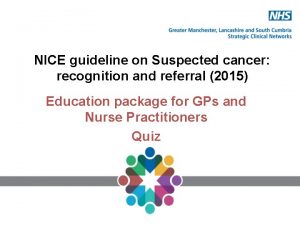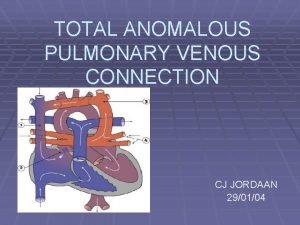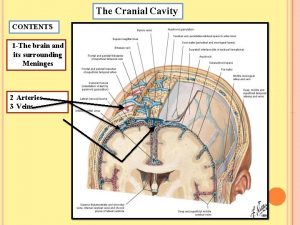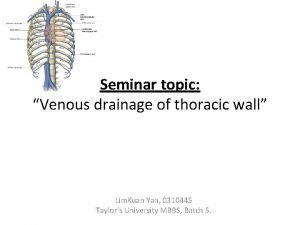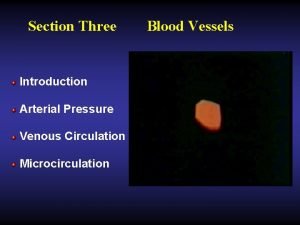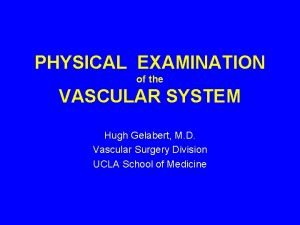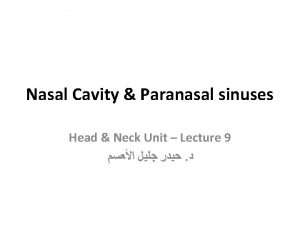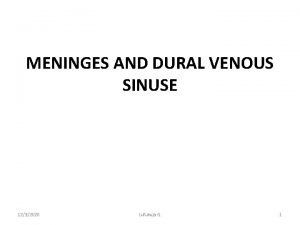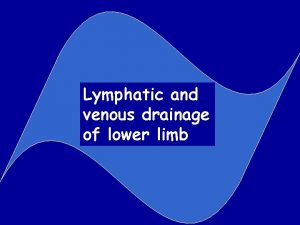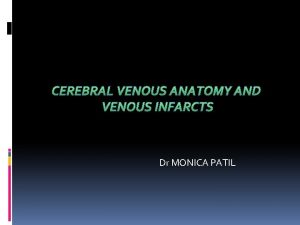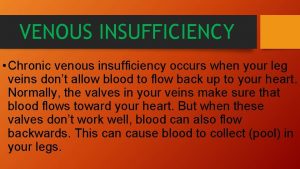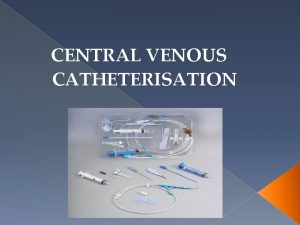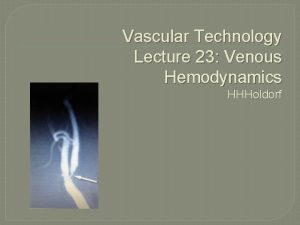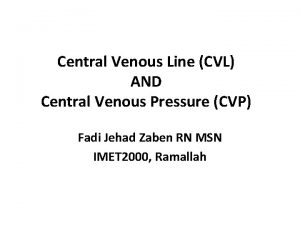Chapter Five Venous Disease Coalition Investigation of Suspected






















- Slides: 22

Chapter Five Venous Disease Coalition Investigation of Suspected VTE Toolkit

Investigation of Suspected DVT • Ascending contrast venography • Impedance plethysmography • Radioactive fibrinogen scan No longer used • Doppler ultrasonography (Duplex scan): sensitive and specific for symptomatic proximal DVT • CT venography: contrast timing critical • MR venography: may be useful for pelvic vein thrombosis VTE Toolkit

Investigation of Suspected DVT • Try to never miss acute PROXIMAL DVT • Some Doppler labs over-call DVT (especially calf DVT) • No one knows if / how calf DVT should be managed • Be aware of CLINICAL-IMAGING DISCORDANCE (the clinical features don’t fit with the imaging results) VTE Toolkit

Clinical Predictive Model for DVT Active cancer < 6 mos 1 Paralysis, paresis, recent plaster cast 1 Bedridden > 3 d or major surgery < 1 mo 1 Localized tenderness along deep vein 1 Entire leg swollen 1 Calf swelling 3 cm > asymptomatic side 1 Pitting edema symptomatic leg 1 Collateral superficial veins 1 Alternative diagnosis > likely Low = < 0 Mod = 1 -2 -2 High = > 3 Wells - Lancet 1997; 350: 1795 VTE Toolkit

D-dimer in Suspected VTE • D-dimers are degradation products resulting from the action of plasmin on fibrin • The presence of D-dimer indicates initiation of blood clotting but many conditions other than DVT give a positive D-Dimer test result • Therefore, a positive D-dimer does NOT rule in DVT, but a negative D-dimer can help exclude the diagnosis • D-dimer may be useful in outpatients with low pre-test probability for VTE as part of a formal algorithm VTE Toolkit

Compression Doppler Ultrasound VTE Toolkit

Compression Doppler Ultrasound Without Compression VTE Toolkit With Compression

Suspected DVT Doppler Ultrasound (DUS) DUS demonstrates DVT Treat DUS negative Low clinical prob or alternative Dx reasonable Stop VTE Toolkit DVT suspicion remains Repeat DUS in 5 -7 days

Suspected DVT in an Outpatient Clinical probability assessment Low Moderate-High D-dimer Negative Proximal DUS Positive DVT excluded Positive Negative Treat • stop • repeat DUS 5 -7 d • use D-dimer VTE Toolkit

Suspected DVT in an Inpatient Proximal Doppler ultrasound Proximal DUS negative DUS demonstrates proximal DVT Continue DVT prophylaxis Treat VTE Toolkit

CT Can Diagnose Proximal DVT VTE Toolkit

Investigation of Suspected PE • No diagnostic value of blood gases in suspected PE • V/Q scans: – At least 60% are non-diagnostic – Consider in some patients with renal dysfunction or severe contrast allergy – Reasonable option for outpatients with normal CXR, and either very high probability of PE or low probability – Role in pregnancy and young women (because of reduced radiation dose) • CT Pulmonary Angiogram (“Spiral CT”): – Accurate for segmental or larger PE – Accuracy and clinical relevance of sub-segmental abnormalities is uncertain VTE Toolkit

Wells Clinical Predictive Model for PE History Previous proven DVT or PE Immobilization > 3 d or surgery prev. month Malignancy (current or < 6 mos. ) Hemoptysis 1. 5 1 1 Physical exam Signs of possible DVT (leg swelling, tenderness HR > 100 3 1. 5 Alternative diagnosis PE as likely or more likely than alternative Pre-test probability score High >6. 0 Moderate 2. 0 -6. 0 Low <2. 0 VTE 41 -50% 16 -19% 1 -2% VTE Toolkit 3 Wells Thromb Haemost (2000) Ann Intern Med (2001)

Revised Geneva Score for PE Assessment based on 8 clinical variables (not on clinical judgment) Points Age > 65 1 Surgery/fracture past month 2 Active cancer 2 Hemoptysis 2 Previous DVT/PE 3 Unilateral leg pain 3 HR 75 -94 3 HR > 95 5 Unilat. edema + tenderness 4 VTE Toolkit Risk Points PE prevalence Low 0 -3 8% Intermediate 4 -10 29 % High > 11 74 % Le Gal – Ann Intern Med 2006; 144: 165

Highly Abnormal Perfusion Scan VTE Toolkit

CT Pulmonary Angiogram VTE Toolkit

VTE Toolkit

VTE Toolkit

Subsegmental “Something” Is it PE? Is it important? VTE Toolkit

Suspected PE in an Outpatient Clinical probability assessment Low ? Moderate D-dimer Negative PE excluded High CTPA Positive CTPA: no PE PE excluded CTPA: nondiag • DUS of prox veins • repeat CTPA: definite PE* Treat *At least segmental filling defect and “reasonable” clinical suspicion VTE Toolkit

Suspected PE in an Inpatient CTPA Definite* PE No definite PE Treat Continue prophylaxis *At least segmental filling defect and “reasonable” clinical suspicion VTE Toolkit

Venous Disease Coalition www. vasculardisease. org/venousdiseasecoalition/ VTE Toolkit
 Suspected cancer recognition and referral
Suspected cancer recognition and referral Suspected cancer recognition and referral
Suspected cancer recognition and referral Communicable disease and non communicable disease
Communicable disease and non communicable disease Five years have past five summers with the length
Five years have past five summers with the length Five of five
Five of five Five elements and five senses
Five elements and five senses Macbeth
Macbeth Summarize locard's principle of exchange
Summarize locard's principle of exchange Lymphatics that accompany the cephalic vein drain into the
Lymphatics that accompany the cephalic vein drain into the Great saphenous vein course
Great saphenous vein course Wrist joint blood supply
Wrist joint blood supply Total anomalous pulmonary venous return
Total anomalous pulmonary venous return Subdural hemorrhage
Subdural hemorrhage Venous drainage of thoracic wall
Venous drainage of thoracic wall Blood circulation
Blood circulation Epicranial aponeurosis
Epicranial aponeurosis Cavernous sinus
Cavernous sinus Dr. gelabert ucla
Dr. gelabert ucla Inferior margin of heart
Inferior margin of heart Venous drainage of nose
Venous drainage of nose Venous tracing
Venous tracing Sinus cerebri
Sinus cerebri Posterior arch vein
Posterior arch vein

